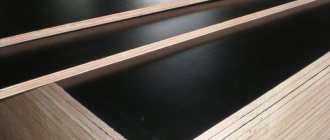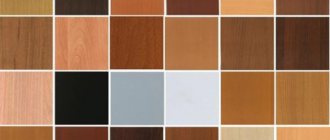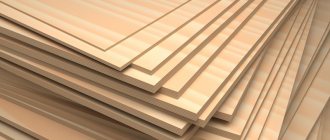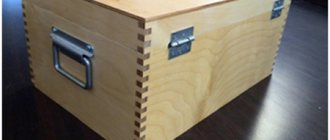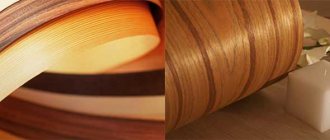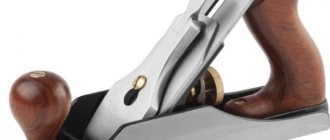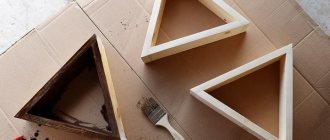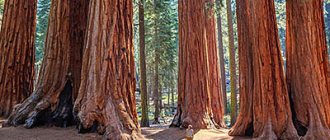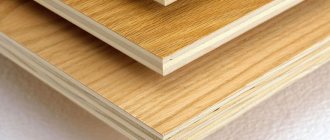Plywood is a widely used type of wood material made by gluing together several sheets of veneer. The number of layers varies over a wide range (from 3 to 20 or more).
In all types of plywood, each subsequent layer is located in such a way that its fibers are at right angles to the fibers of the previous layer. This orientation ensures the strength of the material used in electrical engineering, mechanical engineering, aviation, furniture and other types of industries.
Why sizes matter
The scope of application of plywood is very wide - from construction and finishing works to the manufacture of furniture and home accessories. For each purpose you need to choose the right sheets. And the decisive factor here is thickness. The minimum number of layers is 3 (thickness 3 mm), maximum - 21 (thickness 30-40 mm). Intermediate values are always odd - this rule is observed by manufacturers to improve the mechanical strength of the material.
Variety of plywood in thickness and number of layers
The length and width of the sheet or slab are selected for ease of use: small-sized ones are easier to move and install, and with larger fragments the process goes faster. It is also recommended to compare the size of plywood with the area to be covered and choose the option that will leave less waste.
Watch and be inspired
Plywood is a phenomenally flexible material.
Take a look at what wonderful things craftsmen create from seemingly simple pieces of wood:
Standard and custom sizes
Standard plywood formats are sheets of width 1220 and 1525, length from 1525 to 2500 mm. The most common sizes are 1525x1525 and 1220x2440. They are in great demand due to their ease of operation and transportation. Large format or non-standard sheets are available in widths of 1220, 1500 and 1525 mm, while their length can reach 3660 mm. These dimensions should be used when finishing large areas or for production needs.
Large format and standard plywood
Dimensions and maximum deviation from them are regulated by the state standard for general purpose plywood (GOST 3916.1-96 for hardwood and GOST 3916.2-96 for coniferous wood). The standard provides for the possibility of producing sheets of any size to order.
| Sheet length in mm | Permissible deviation (+/-) in mm |
| 1200-1250 | 3 |
| 1500-1830 | 4 |
| 2100-2500 | 4 |
| 2700-3660 | 5 |
Conclusion
As you have already noticed, plywood is quite a promising building material with a beautiful natural texture, which gives it special value when decorating exteriors and interiors. In addition, thanks to new modifications, produced in the most convenient sizes and with unique properties, the scope of plywood products is expanding more and more every year.
And the most amazing thing is that modern plywood gives access to volume in terms of design, allows you to immerse yourself in three-dimensional space, lighten structures - this is very comfortable, especially if you create something non-standard with your own hands. In the video presented in this article you will certainly find additional information on this topic. We hope you find it interesting and useful!
Thickness and purpose of plywood
The thickness of the plywood sheet depends on the number of layers of veneer. Each of them can be from 1 mm (hulled) to 3.5-4.0 (planed). Rotary cut veneer material is more flexible. In terms of strength characteristics, planed is better.
Production of planed and peeled veneer
The layers are connected with glue under pressure, so that the direction of the wood fibers in them does not coincide - this significantly improves the ability of the material to withstand mechanical damage. The composition of the adhesive determines the level of moisture resistance and safety of plywood:
- FSF (glued with phenol-formaldehyde resins) - used only for non-residential premises and outdoor work, high moisture resistance (thickness 4-40);
- FKM (use melamine resins) – average water resistance and safety;
- FC (formaldehyde and urea-formaldehyde resins) – used exclusively for interior work, does not withstand moisture (thickness 3-24);
- FBA (glued with albumin casein glue) is an environmentally friendly material, non-moisture resistant (sheets with a thickness of 3-8 are produced);
- FB (or bakelite plywood) - withstands any environmental influences, including high humidity, open fire, mechanical damage (available in thicknesses 7-40), used in shipbuilding, automobile production, construction of podiums, stadiums.
Bakelized (bakelite) plywood
Thickness 3mm
Plywood with a thickness of 3 mm or less is called aircraft grade. Previously, it was used in the aircraft industry, but now it is used mainly in modeling. The material bends easily, so unusual interior items are made from it. Available in two sizes 1525x1525 and 1525x1830. Packaged in packs of 130 pcs. Total weight 590 and 707 kg respectively.
Thickness 4 mm
The scope of use of such a sheet is already wider. It is suitable for the production of furniture, wall decoration and even flooring. As a rule, it consists of 3 layers of veneer. The most popular size is 1525x1525.
Thickness 6.0, 6.5 mm
Five-layer sheets for construction and furniture assembly. The thickness allows you to produce fragments up to 3 meters long. The most common sizes: 1525x1525, 1220x2440, 1500x3000.
Plywood 8, 9,10 mm
Sheet of 7 layers of veneer. It is used for both finishing and furniture production. The material will withstand the load as a floor when laid in one layer. Available sizes: square 1525x1525, rectangle 3000x1500, 1220x2440.
Plates 12, 15 mm
Sheets of plywood whose thickness exceeds 12 are called slabs. They consist of 9 or more layers of wood. They are used for the construction of structures that require heavy loads: shelving, partitions, floors.
Plates 18 - 30 mm
To produce these boards, 15 or more layers of peeled veneer are glued together. When using planed, their quantity is approximately 2 times less. This plywood is very durable and is used for interfloor slabs, decking, formwork for foundations, and the construction of summer kitchens.
Plywood 35-40 mm
The thickest slabs produced by factories are used in the production of pallets, brick making machines, countertops, and stairs. The sizes are varied: 1220x2440, 1250x2500, 1500x3000, 1525x3050.
The standard provides for a maximum deviation of the sheet thickness from the declared one.
The maximum deviations allowed by GOST are invisible to the eye
Brief characteristics of varieties
For the production of plywood, veneer obtained from different types of wood is used using various technologies. Plywood varieties have letter and numerical designations, differ in the nature of the raw materials used, and the specifics of mechanical processing.
Grade E
The most expensive products are designated by the letter E - the first letter in the English spelling of the word “elite”. The material has no defects, is intended for finishing luxury premises, and has a high cost. On an area of 1 m2, the presence of microscopic knots the size of a pinhead is allowed in a maximum quantity of 3 pieces.
1st
Plywood of this grade may have small light spots of growth, small knots and areas where minor repairs have been made. Each square meter can contain no more than 5 healthy knots up to 15 mm in size; no more than 3 wormholes, holes up to 6 mm.
The cost of such material is lower than that of elite varieties, which allows it to be widely used both for external decoration and for internal cladding work.
2nd
Plywood classified as 2nd grade has noticeable defects in the form of cracks up to 20 cm long, medium-sized knots, light or dark spots of growth in the amount of 6 to 10 pieces with sizes from 6 mm to 25 mm. The standards allow the presence of stains of leaked glue on an area not exceeding 2% of the total dimensions of the sheet.
3rd
The material of this group may have knots with a diameter reaching 70 mm, large cracks in quantities, the maximum of which is not limited. A decent look can be given to grade 3 plywood only by finishing done by experienced craftsmen using special varnishes and paints.
4th
Grade 4 plywood has the most affordable prices and conditionally acceptable quality, which allows it to be used for packaging, in some cases for rough finishing. The material may have knots, numerous wormholes, and spots. The edges may not have very smooth contours; Deviations from a flat axis are allowed, reaching half a millimeter, which is not very significant against the background of the overall dimensions of the sheets.
Laminated plywood
These sheets are produced in the same way as the main ones, the main difference is that on top, on one or both sides, they are covered with a thick film. It protects plywood from moisture and gives it an attractive decorative look. Laminate sheets with a thickness of 9 to 40 mm. Their standard dimensions are 1220x2440, 1250x2500. Marked with the abbreviation FOF.
The scope of application of laminated boards is very wide: the construction of structures, interior and exterior decoration of buildings, furniture, and decorative items.
Laminated moisture resistant plywood
Raw materials and surface treatment
Plywood sheets are made from wood raw materials of both soft and hard species. Additional processing improves the performance of the material.
Conifers
Coniferous veneer is used to make plywood for furniture, and it can be located throughout the entire thickness of the product or only in the outer planes. When coniferous veneer is placed on the outside, hardwood material is used as internal layers, and the product belongs to the combined types. The most common plywood is made from pine; spruce, cedar, and larch wood are also used.
Birch, poplar and other hardwoods
Birch veneer is used for the production of multifunctional plywood products for a wide range of purposes, the use of which can only be restrained by higher prices than for pine needles. Currently, the market is filled with Chinese poplar veneer plywood; The price of the material is quite small, the quality leaves much to be desired.
In addition to birch and poplar, alder, aspen, linden, beech, and maple are used for the outer layers. The product gets its name from this layer. Sheets of plywood, topped with oak, ash, and exotic wood veneers, are used to make decorative carved panels. Compared to wood, they have a lower price, and are in no way inferior in beauty.
Sanded and unsanded sheets
Sheets of all sizes are subject to surface treatment, which can be carried out using different algorithms. Unsanded plywood (NSP) has low prices, which is used as a technical material for rough finishing and the manufacture of packaging containers. During operation, cracks, chips, and defects may appear on a rough, rough surface.
The polished surface significantly improves the decorative properties of plywood, allowing it to be used for the production of furniture and interior decoration of rooms. Grinding can be performed on one (Ш1) or two sides at once (Ш2); the process significantly increases the moisture resistance, durability and, accordingly, the price of plywood sheets of all sizes.
Laminated products
Laminated types of plywood, on the surface of which a layer of hardened oiled paper is fixed, have increased resistance to abrasion and other mechanical stress. This type is sometimes called formwork, since it is often used for arranging reusable formwork. Durable laminated panels serve as partitions on ships; they are used to make subfloors, elements of playgrounds, and outdoor furniture.
To form some types of laminates, resins from phenol, melamine, and polyvinyl chloride are used. Sheet planes and ends of any size are finished with a polymerized coating, which ensures the durability and durability of the products and their high aesthetic qualities.
What other differences exist?
The material in question differs not only in brand, but also in some other parameters:
- Variety. There are four grades of material. It’s easy to guess that the higher the grade, the fewer visible defects the veneer sheets have;
- Breed. As a rule, veneer is made from either coniferous trees or birch. The first is characterized by higher moisture resistance, and the second by strength;
Laminated plywood has an attractive appearance and good moisture resistance
- Type of processing . The surface of the sheet can be unsanded, sanded, laminated or finished with decorative paper. It must be said that lamination gives the material increased moisture resistance.
Otherwise, the type of surface is selected depending on the area of application of the material. For example, unsanded sheets are suitable for rough work, but for painting it is better to use sanded material.
To give the surface of the sheet the appearance of expensive wood, you can glue veneer of valuable wood with your own hands.
Most common sheet sizes
Main settings
This product is a building material that is made from many layers of natural wood glued together under the influence of a press.
Note! To increase reliability, the layers are laid alternately so that the wood fibers are directed perpendicular to each other.
If it is necessary to protect the raw material from torsion or bending, the layers can be placed at an angle of 30º, 45º or 60º.
Modern technologies make it possible to produce sheets of different types:
- sizes;
- thickness,
- functional and external features.
Regular sheets can be of two types of shapes:
- rectangular;
- or square.
Length
Most often, rectangular slabs are used; the standard size of a plywood sheet is 1525x2440 mm, or square with a side of 1525 mm. There is also a range of standard sizes for larger sheets, the maximum value of which is 3660 mm.
Standard sheet length
Note! Any other shapes and configurations are achieved by cutting plywood and shaping it to the required dimensions.
Thickness
The thickness of the sheet is of great importance for calculating the load that will be placed on it during operation. Naturally, the thicker the plywood, the stronger and heavier it is. But as the thickness increases, the price also rises, so before making a purchase, you need to carefully study this parameter.
Building materials of various thicknesses
Specialized enterprises equipped with modern technologies produce unusually thin finishing plywood of non-standard sizes in thickness - from 1 to 3 mm. This ultra-thin material is used primarily in aviation to reduce the overall weight of aircraft trim. Under normal conditions, plywood with a thickness of 3-12 mm is called thin.
Density
Density also has its own standards:
- for bakelized or aircraft plywood this parameter should be equal to 1200 kg/m3;
- for the rest – 640-700 kg/m3.
Standard and large format products
The manufacturer produces wood-laminated boards in both standard and large formats. Large-format material is intended for large customers who use it on an industrial scale. Large format sheet sizes are as follows:
- 1830 x 1525;
- 2440 x 1220;
- 2500 x 1250;
- 3000 x 1500;
- 3050 x 1525 mm.
Enterprises make even larger panels, but such products are produced only on special orders and are not standard. Additionally, custom plywood sheet sizes are created when the manufacturer trims the panel to remove defective veneer. The result is substandard products.
Standard plywood sizes are presented in a small list:
- 1220 x 1220;
- 1220 x 1525;
- 1270 x 1270;
- 1270 x 1250;
- 1350 x 1525;
- 1475 x 1475;
- 1475 x 1525;
- 1525 x 1525 mm.
Table of thickness and ply layers of plywood sheets.
From the list it can be seen that the panels are available in both rectangular and square shapes. It should be noted that FSF brand products are produced only in rectangular shapes. At the same time, the FC brand is produced in both forms. The typical size of a sheet of FC plywood is either 1220 x 1525, or 1270 x 1525, or 1525 x 1525 mm.
The dimensions of the FSF differ:
- 1525 x 3050;
- 1500 x 3000;
- 1250 x 2500;
- 1220 x 2440 mm.
The large sizes of plywood of this brand are due to the fact that FSF is in demand in the furniture industry, various branches of mechanical engineering and capital construction.
Design
Plywood board is sheets of wood veneer glued together into a monolithic whole using special equipment using formaldehyde resins. For the outer layer the thickness should not be higher than 3.5 mm, and in the inner layers it should not exceed 4 mm. Plywood can be assembled using various technologies, using veneer from one type of wood or from several types of wood. According to these indicators, it is divided into homogeneous and combined, which may include various types of deciduous or coniferous cuts. The arrangement of fibers in sheets can be parallel or mutually perpendicular, and also differ in symmetry.

